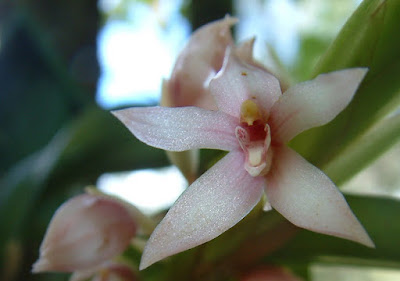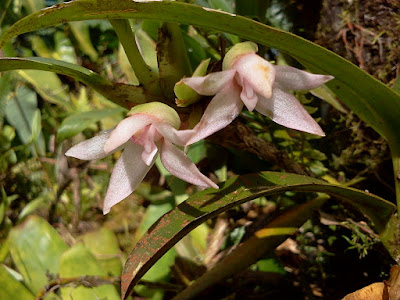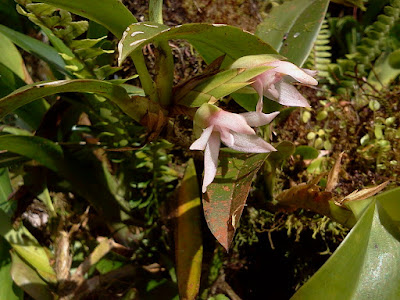Maxillaria sigmoidea - S Shaped Lip Maxillaria flowers are 2 cm in diameter, slightly campanulate; sepals and petals are wine red...
Maxillaria sigmoidea, also called as S Shaped Lip Maxillaria, Camaridium sigmoideum, Ornithidium sigmoideum, Viracocha sigmoidea, is a species of the genus Maxillaria. This species was described by Oakes Ames and Donovan Stewart Donovan Stewart in 1943.
DESCRIPTION OF MAXILLARIA SIGMOIDEA - S SHAPED LIP MAXILLARIA
Maxillaria sigmoidea is native to Costa Rica to Panama. It is found growing in humid forests in Costa Rica, Panamá at elevations around 1200 meters above sea level.
It is a medium to just large sized, cool growing epiphyte which reaching up to 60 cm in height with an ascending, stem-like rhizome and multiple rhizomatic stems that grow from the base of one pseudobulb giving the appearance of branching. The pseudobulbs are unifoliate, elliptic, compressed, rugose, spaced 10-20 cm apart on the rhizome. The single leaf is apical, lanceolate, acuminate, membraneous, carinate, conduplicate below into the petiolate base, very variable in size, up to 15 cm long, with 3 cm long petiole.
S Shaped Lip Maxillaria blooms in spring from the axillary, single flowered inflorescence that arise from the axils and are enveloped by sheaths with inflated, red-brown, acute floral bracts. The flowers are 2 cm in diameter, slightly campanulate; sepals and petals are wine red, intermediate lobe of the lip is paler, the lower half of the lip has carmine patches, the front of the column has red stripes, anther and pollinia are white.
MAXILLARIA SIGMOIDEA - S SHAPED LIP MAXILLARIA CARE AND CULTURE
Cultural information should only be used as a guide, and should be to be adapted to suit you. Your physical location; where you grow your plants, how much time you have to devote to their care, and many other factors, will need to be taken into account. Only then can you decide on the cultural methods that best suit you and your plants.
Light:
Maxillaria sigmoidea needs a light level of 18000-25000 lux. Moderately bright light should be filtered or dispersed, the plants should never be exposed to the direct effects of the midday sun. The strong air movement should be ensured at all times.
Temperature:
The average temperature of the summer day is 23-25 °C, night 14-16 °C with daily amplitude of 8-9 °C. If a cooling air humidifier is used, the plants will grow well near the cold, moist outlet. In winter, the average day temperatures are 17-18 ° C, and the night around 10 ° C with the daily amplitude of 7-8 ° C.
Humidity:
S Shaped Lip Maxillaria needs the humidity of about 70-80% for most of the year. Too dry air has a negative effect on the development of the plant: its growth is inhibited, and the leaves begin to turn yellow and dry out. The higher temperature, the higher the humidity should be, and the higher the humidity, the more often and longer it is necessary to ventilate the room where the plants are contained, otherwise the probability of rotting and various kinds of fungal diseases. Good air movement is essential while the plants are in leaf and growing.
Substrate, growing media and repotting:
Maxillaria sigmoidea can be grown both in pots with good drainage as well as mounted on a piece of cork oak or tree fern. However, it should be remembered that in the second case the plants require high humidity, and during hot and dry weather it may be necessary to water several times each day.
For this reason, it is easier to grow in pots or hanging baskets filled with very loose, quickly drying substrate. The most commonly used growing medium is medium-sized fir bark or shredded tree-fern fiber with the addition of coarse pearlite to keep the substrate cool while providing the right amount of moisture. The addition of charcoal also has a positive effect on the structure of the substrate and prevents its acidification.
The plants should be repotted immediately if the substrate is decomposing or when the pot is too small. Repotting is best done at the time of emergence of new roots, which guarantees that the plant will regenerate its strength in the shortest possible time.
Watering:
S Shaped Lip Maxillaria should be watered frequently while they are actively growing, but there should be excellent drainage and the roots need to dry out quickly after watering. When the new growths reach maturity in the fall, the amount of water should be reduced.
Fertilizer:
During the period of active growth, the plants should be fertilized every week with 1/4-1/2 doses of fertilizer for orchids. You can use sustainable fertilizer throughout the year, but also can use a high nitrogen fertilizer from spring to mid summer, then in late summer and autumn use fertilizer with a predominance of phosphorus.
Rest period:
Maxillaria sigmoidea does not need a rest period in winter, and such conditions should be maintained throughout the year. In winter, the amount of water should be reduced somewhat, especially if the plants are grown in cooler conditions, or in the darker, short day conditions, but the plants should never be completely without water. Fertilization should be reduced or eliminated until new growths appear and watering begins more abundantly in the spring.















COMMENTS